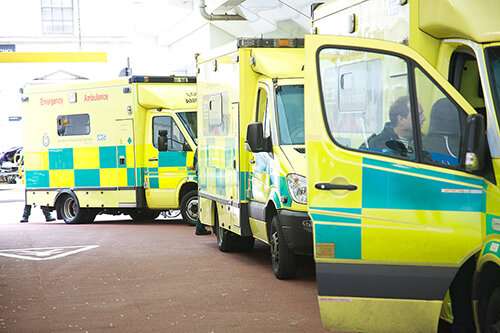
The research team, based at the NIHR Applied Research Collaboration (ARC) West in collaboration with the West of England Academic Health Science Network (AHSN), studied the impact of NEWS scores collected for more than 13,000 urgent GP referrals to hospital. They found that higher scores are associated with patients being taken to hospital by ambulance more quickly. Average transfer time was 94 minutes for patients with the highest scores, compared with 132 minutes for those with the lowest. Patients with high scores were also reviewed more quickly after arriving at hospital.
Patients with higher scores were sicker, with longer hospital stays and more of them being admitted to intensive care. Patients with the highest scores were nearly five times more likely to have sepsis than those with the lowest scores and eight times more likely to die within two days of hospital admission.
Early warning scores (EWS) are designed to help healthcare staff identify patients whose condition is deteriorating, to allow them to get the treatment they need quickly. Higher scores indicate poorer health.
The National Early Warning Score (NEWS) is a simple scoring system of six clinical measurements which are added together to give an overall score, with various thresholds triggering different clinical responses.
National Early Warning Scores are already used in hospitals across England and by ambulance call handlers and paramedics for triage. However, they aren’t consistently used outside hospital and ambulance services, for example in GP surgeries and community settings.
The researchers also suggest that patients and carers could benefit from education about NEWS to enable the sickest patients to be transferred to hospital quickly.
These findings come at a time when the Royal College of General Practitioners (RCGP) is endorsing the use of NEWS in GP surgeries as part of a system-wide response to the COVID-19 pandemic, with new guidance for GPs issued last week in their COVID-19 resource hub.
Lauren Scott, Senior Research Associate at NIHR ARC West, said: “Ambulance call handlers, paramedics and hospital staff are already using NEWS to triage patients. We believe calculating NEWS at an earlier point in the patient pathway, in GP surgeries for example, could help the sickest patients receive timely care and therefore save lives. Our findings are particularly relevant in the context of the coronavirus pandemic, as some COVID-19 patients develop sepsis as a result of the infection.
“We found that higher NEWS values recorded at referral into hospital were associated with poorer clinical outcomes, which is to be expected as these patients will usually be the most ill. But we also found that higher NEWS scores meant patients conveyed by ambulance were taken to hospital more quickly, and were assessed more quickly when they got there.”
Dr. Alison Tavare acute; GP and Primary Care Clinical Lead at the West of England AHSN, said: “As a GP I use NEWS alongside clinical judgement when arranging admissions to help secondary care colleagues decide where patients should be seen, by whom, and with what urgency. I feel strongly that NEWS also protects me as a clinician; if a patient unexpectedly has a high NEWS it makes me think ‘have I missed something?”
Source: Read Full Article
